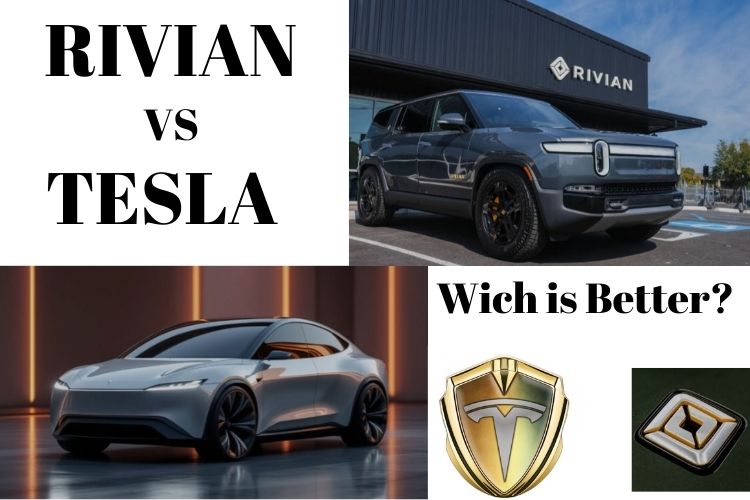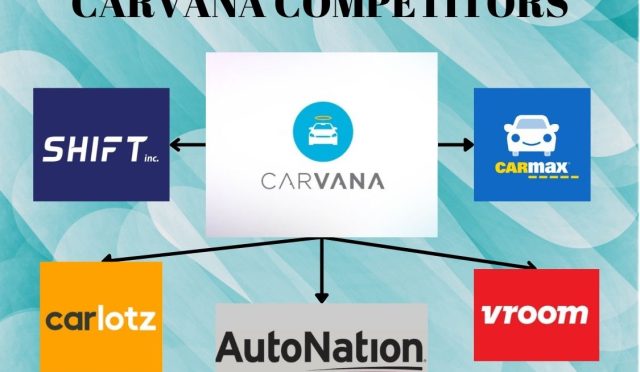Introduction
The electric vehicle (EV) market has been booming in recent years, with two companies standing out: Rivian vs Tesla.
Fossil fuel-powered vehicles contribute significantly to environmental pollution due to their carbon emissions. However, the energy efficiency, lower operating costs, and eco-friendly nature of electric vehicles have made them a more preferred choice over traditional fuel-powered cars.
So, who is the dominant player in the EV market? What are the competitive advantages of these vehicles over one another? And which electric vehicles should we choose and why—Rivian vs Tesla? Let’s explore these questions.
While Tesla has long been the dominant player in the market, Rivian’s unique approach to electric vehicles and future vision poses a potential threat to Tesla’s reign. This article offers a comprehensive comparison of Rivian vs Tesla by examining their history, products, performance, and future prospects
Rivian vs Tesla: Companies Overview
| Feature | Tesla | Rivian |
|---|---|---|
| Founded | 2003 | 2009 |
| Founder(s) | Elon Musk, Martin Eberhard, Marc Tarpenning, JB Straubel, Lan Wright | Robert “RJ” Scaringe |
| CEO | Elon Musk | Robert “RJ” Scaringe |
| Mission | Accelerate the world’s transition to sustainable energy | Keep the world adventurous forever |
| Employees | ~127,855 | ~14,000 |
| Headquarters | Austin, Texas, USA | Irvine, California, USA |
| Countries of Operation | US, China, Germany (manufacturing); Global (sales & service) | US (manufacturing); Expanding within the US (sales & service) |
Tesla was founded in 2003, while Rivian was established in 2009. At first glance, the six-year gap may not seem significant, but consider what can happen in terms of technological development within that time. This makes Tesla’s earlier establishment a competitive advantage over Rivian.
When we look at the estimated workforce, Tesla has nearly nine times more employees than Rivian. Evaluating this from a Rivian vs. Tesla perspective, this factor can be seen as both an advantage and a disadvantage for both companies. A larger workforce means higher labor costs and potentially higher turnover rates. However, it also translates to higher production capacity and greater sales potential.
Tesla vs Rivian: Market Dominance and Market Value
| Metric | Tesla | Rivian |
|---|---|---|
| Market Share (US) | ~65% | ~2% |
| Market Value | ~$500 billion | ~$30 billion |
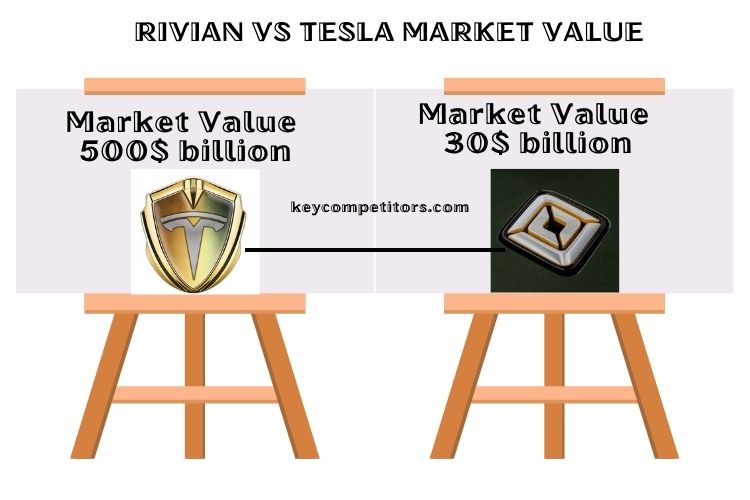
When evaluating market shares, Tesla dominates with a 65% share, clearly leading the industry. On the other hand, Rivian, with a modest 2% market share, is still in its early stages of gaining a foothold in the market.
In terms of market valuation, Tesla is already at the top, holding a commanding position. However, Rivian’s valuation of $30 billion is not insignificant and reflects its potential in the growing EV sector.
Rivian vs Tesla: Product Showdown
- Tesla: Model S (luxury sedan), Model 3 (compact sedan), Model X (SUV), Model Y (compact SUV), Cybertruck (pickup truck – upcoming)
- Rivian: R1T (pickup truck), R1S (SUV), Electric Delivery Vans (EDV) for Amazon
When comparing Rivian and Tesla in terms of product range, we can say that both competitors are relatively close. Tesla offers a lineup of five vehicles, while Rivian currently has three models in its portfolio
Rivian vs Tesla: Financial Performance (2024 Estimates)
| Metric | Tesla | Rivian |
|---|---|---|
| Revenue | $81.5 billion | $1.6 billion |
| Net Income | $12.6 billion | -$6.75 billion (net loss) |
| Deliveries | 1.31 million vehicles | 24,337 vehicles |
Note: You can check the accuracy of the data by visiting the investor relations pages of both companies.
Rivian vs Tesla: Strengths and Weaknesses
| Feature | Tesla | Rivian |
|---|---|---|
| Strengths | + Established brand and strong customer loyalty + Extensive Supercharger network Advanced technology (Autopilot, FSD) + High performance and long range Large production capacity | + Off-road capability + Unique design and features (Gear Tunnel, Camp Kitchen) + Strong early reviews and positive reception + Amazon backing and partnership |
| Weaknesses | – Inconsistent build quality – Customer service challenges – Premium pricing | – Limited production and long wait times – Smaller charging network – Unproven long-term reliability |
Rivian vs Tesla: Investment and Future Plans
Tesla
- Investments:
- Advanced battery technology (4680 cells) to enhance energy density and reduce costs.
- Expansion of production capacity through new Gigafactories.
- Development of autonomous driving technology, including the Robotaxi network.
- Future Projects:
- Launch of the Tesla Juniper, longer range and more sporty
- Global market expansion to strengthen its leadership in EV adoption.
Rivian
- Investments:
- Expansion of its manufacturing facilities to meet growing demand.
- Development of the Rivian Adventure Network, a dedicated EV charging infrastructure.
- Increased R&D focus on the R2 platform for future vehicle models.
- Future Projects:
- Boosting production capacity to scale operations efficiently.
- Expanding its charging infrastructure to improve customer experience and reach.
Evaulation: When we evaluate Rivian and Tesla’s investments and future plans, it becomes evident that Rivian is still focusing on capacity expansion and building out its charging station network. In contrast, Tesla is concentrating on enhancing its technology and maintaining its existing market position.
Comparing Rivian and Tesla in terms of investments and future projects, it’s clear that Rivian still has a long way to go compared to Tesla. While Tesla continues to invest in innovative technologies and forward-looking projects to sustain its market leadership, Rivian is still in the process of building scalable production capabilities and a robust infrastructure.
This highlights Rivian’s growth potential but also suggests that Tesla’s dominance in the sector is likely to persist for some time
Rivian vs Tesla: Head-to-Head Comparison
- Target Market: Tesla targets a broader audience with a wider range of vehicles, while Rivian focuses on the adventure and outdoor enthusiast market.
- Technology: Tesla prioritizes cutting-edge technology and performance, while Rivian emphasizes practicality and off-road capability.
- Pricing: Rivian vehicles generally have a higher starting price than comparable Tesla models.
- Charging Infrastructure: Tesla has a significant advantage with its extensive Supercharger network.
Rivian vs Tesla: Safety Tests
In terms of crash tests, the first organizations that come to mind globally are IIHS (Insurance Institute for Highway Safety), NHTSA (National Highway Traffic Safety Administration), and Euro NCAP (The European New Car Assessment Programme). The tests conducted by these organizations are completely reliable. Many people refer to the results of these tests before deciding to buy a car. Since accidents are unpredictable, safety comes before money. Let’s take a look at the safety tests both of these brands have undergone and their results.
Euro NCAP
These tests are generally for vehicles sold in Europe, which is why Rivian hasn’t participated in them.
Tesla Model 3 2019 Euro NCAP Result
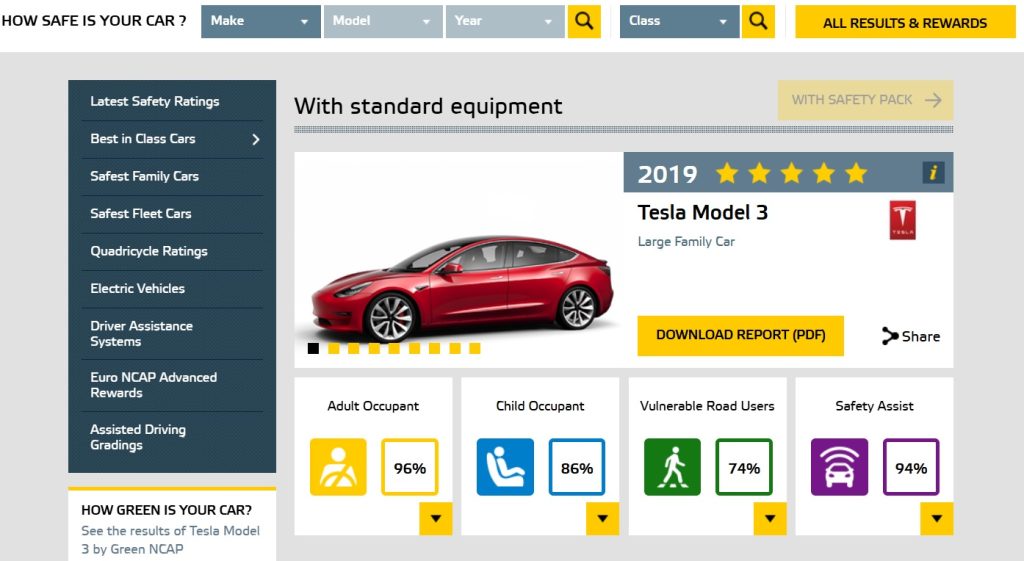
- Adult Occupant: 96%
- Child Occupant: 86%
- Vulnerable Road Users: 74%
- Safety Assist: 94%
We can easily say that these results are excellent.
Tesla Model Y 2022 Euro NCAP Result
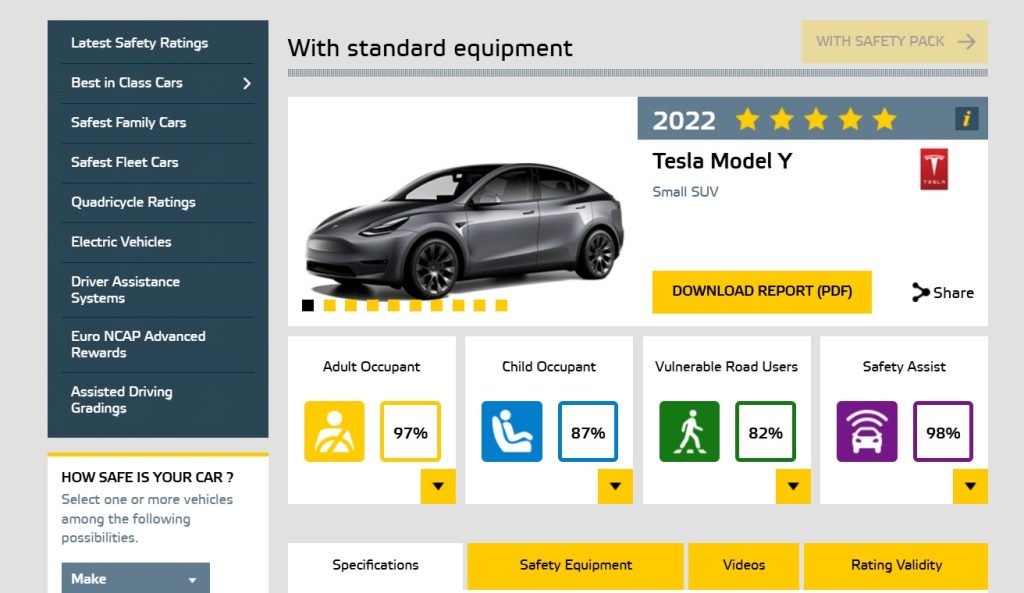
- Adult Occupant: 97%
- Child Occupant: 87%
- Vulnerable Road Users: 82%
- Safety Assist: 98%
To evaluate these results in one word: Perfect! Here we can see that the Tesla Model Y performs significantly better than the Model 3.
IIHS
Rivian R1S
Guess who is the champion in the Large SUV category according to the 2025 IIHS results? The answer: Rivian R1S.
We can sum up this result with one word: Champion!
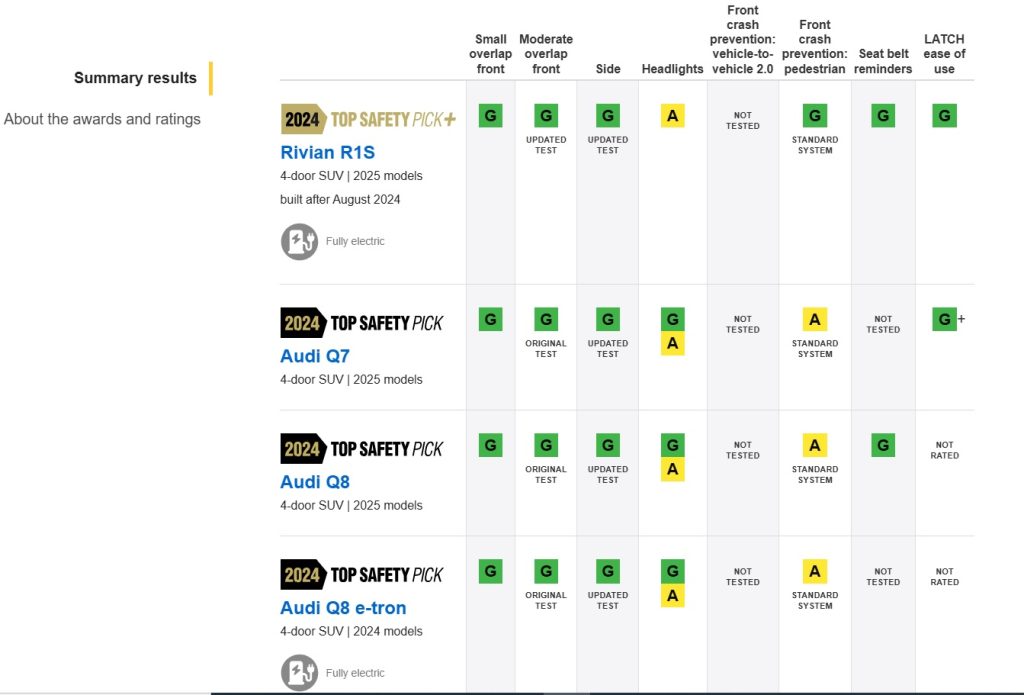
Tesla Model Y
In the 2024 Midsize Luxury SUV category, it received the “Top Safety Pick+” rating, demonstrating how much Tesla prioritizes safety. İf you would like to review the results in detail, we are providing a link here.
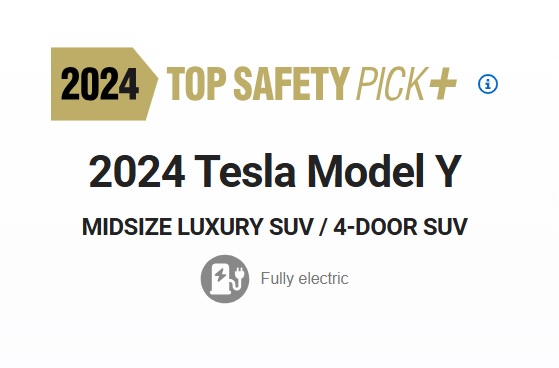
Structural Safety and Active Safety Features
If you drive an electric vehicle, the safety of the batteries is very important. From our research, we know that both Rivian and Tesla use special designs for battery safety, and the tests above support this.
In addition, both brands have advanced active safety features such as autopilot. However, the principles behind these systems are different. Tesla’s Autopilot system relies on cameras and radars, while Rivian also uses lidar sensors to collect more data. It’s hard to definitively say which system is safer, but we can comfortably say that both brands use top-notch quality and technology.
In summary, both brands passed the safety systems tests with flying colors and earned full marks from us.
Rivian vs Tesla: Advantages and Disadvantages
- Tesla Advantages: Wide range of models, access to Supercharger network, advanced technology features, strong resale value.
- Tesla Disadvantages: Higher initial cost, potential quality control issues, concerns about customer service.
- Rivian Advantages: Rugged off-road capability, unique design and features, potential for adventure and outdoor activities.
- Rivian Disadvantages: Higher price point, limited model availability, less developed charging infrastructure.
Conclusion
Rivian vs Tesla! These two rivals represent two different strategies in the electric vehicle (EV) revolution. Tesla, as the established leader in the industry, is known for its strong brand, extensive charging infrastructure, and technology-driven approach. Tesla’s advancements in battery technology, autonomous driving systems, and the Supercharger network have positioned it as a pioneer in the EV market.
Rivian, on the other hand, is a newer player that differentiates itself with vehicles designed for adventure-focused and outdoor-loving users. With off-road capabilities, unique design, and a lifestyle connected to nature, Rivian targets a different market segment. While Tesla’s long-established technology and infrastructure provide it with a significant advantage, Rivian’s offerings cater to nature enthusiasts and those who enjoy outdoor activities, making it an appealing alternative for a specific audience.
In conclusion, Tesla’s leadership is reinforced by its technology and infrastructure, while Rivian’s innovations and adventure-oriented approach make it attractive to a different customer base. If you liked this review, you can also review our article on trending posts here. Best wishes from keycompetitors.com

